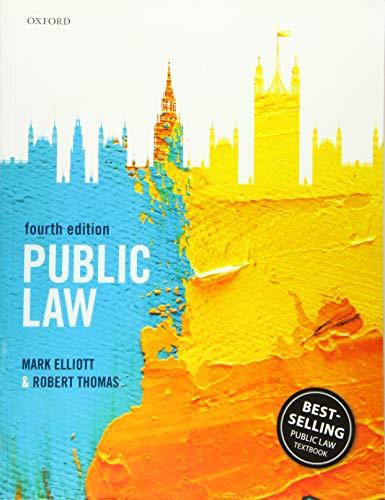Question
States A, B, C, D and E signed a treaty which provided for free movement of all agricultural products grown/produce in any of the contracting
States A, B, C, D and E signed a treaty which provided for free movement of all agricultural products grown/produce in any of the contracting party (The Treaty). This means that States A, B, C, D and E agree that no customs duties and charges equivalent to customs duties (CEEs), such as inspection fees, will be imposed on agricultural products imported from the territory of any contracting party. The Treaty allows a contracting party to carry out free inspections of agricultural goods if there is evidence that a product in question constitutes a danger or a potential danger to health or life of humans, animals or plants. The Treaty was subject to ratification by each of State A, B, C, D, and E.
State A is a world producer of goat cheese. 80% of the farmers in State A are engaged in the production of goat cheese. They strongly oppose the free movement of goat cheese. Under pressure from farmers, State A ratified the Treaty but, at the time of ratification, made the following statement.
"Only up to 50 kilograms of goat cheese imported from each contracting party per month will be in free circulation in State A. On any amounts of goat cheese exceeding 50 kilograms per month State A will impose usual customs duties and CEEs"
State B is known worldwide for the quality and style of leather shoes made in that State. Manufacturers of shoes in State B put pressure on the government of State B to include the following statement at the time of ratification of the Treaty:
"State B understands that products made of animal leather should not be regarded as agricultural products. If this understanding of State B is not accepted by the contracting parties, State B will no longer wish to be a contracting party to the Treaty".
In State C, its citizens, who love milk, and have always taken great care of their health, put pressure on the government to include, at the time of ratification of the Treaty, the following statement:
"All milk coming from any contracting party will be subjected to mandatory inspections which will be free of charge. However, the producers of milk will have to store milk during any inspection in the facilities provided by the government. The government will charge storage fees of $ US 10 per 1000 hectolitres of milk per day".
State D ratified the Treaty, but made an objection to the statements made by States A, B and C, whilst allowing the Treaty to enter into force between itself and States A, B and C.
State E ratified the Treaty and accepted all statements made by States A and C. However, it made an objection to the statement made by State B and objected to the entry into force of the Treaty.
Assume that the Treaty has been in force for 13 months.
Briefly explain the relationship that the Treaty has created between the contracting States using the following as an example:
Example:
The relationship under the Treaty between States D and E.
State E made no statements. Therefore, State D did not need to react to any statements made by State E. State D made no statements. Thus, there was no need for State E to react to any statements. Objections made by State D were addressed to States A, B and C, and not to State E.
For State D all agricultural products imported from State E to State D will pay no customs duties and CEEs. Similarly, all agricultural products imported from State D to State E will be free of any customs duties and CEEs. There will be the free movement of all agricultural products between States D and E.
A.The relationship under the Treaty between States E and A [4%]
B.The relationship under the Treaty between States C and D [4%]
C.The relationship under the Treaty between States B and A [4%]
D.The relationship under the Treaty between States D and A [4%]
E.The relationship under the Treaty between States B and D [4%]
F.The relationship under the Treaty between State E and State B [4%]
Step by Step Solution
There are 3 Steps involved in it
Step: 1

Get Instant Access to Expert-Tailored Solutions
See step-by-step solutions with expert insights and AI powered tools for academic success
Step: 2

Step: 3

Ace Your Homework with AI
Get the answers you need in no time with our AI-driven, step-by-step assistance
Get Started


